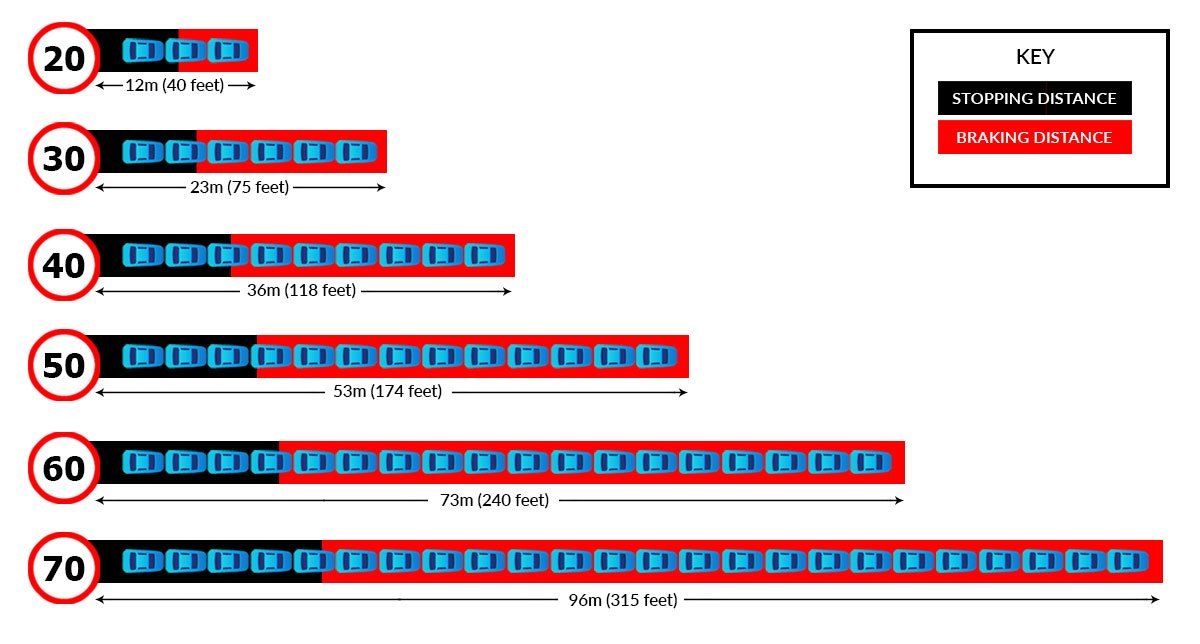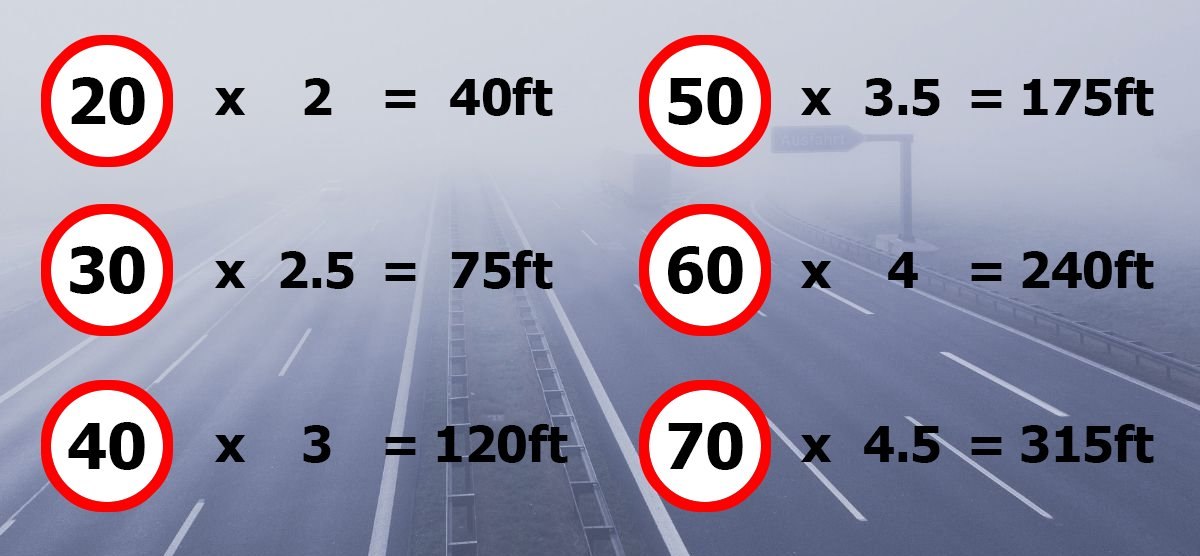Are you aware of different safe stopping distances? Or what factors can affect stopping distances in the UK?
If you answered no, then the good news is you’re not alone. Many of us clue-up on safe stopping distances before we take our theory test, but once we’ve got our certificate few of us will give it a second thought. From experience, this is often because the numerical number you are required to pull from your memory during your theory test means little to you in real life.
It’s hardly surprising then, that being followed too closely by a car (tailgated) is one of the biggest causes of road accidents.
While being tailgated is extremely frustrating and can put you under intense pressure, if you aren’t aware of stopping distances, it’s actually easy to do inadvertently. So to help ensure you don’t fall foul to this dangerous driving practice we have compiled all you need to know about stopping distances, along with relatable information that you’ll be able to apply on your daily drive.
What is a safe stopping distance?
The term safe stopping distance refers to the distance you need to leave between you and the car in front to safely stop in an emergency situation without going into the back of them.
It is a crucial aspect of staying safe on the road and is made up of two key aspects; thinking distance and braking distance.

Thinking Distance
The thinking distance is literally how long it takes a driver to react to hazards and apply the brakes. The Highway Code works this out as an average, as the actual reaction time will vary from driver to driver. On top of this, various other factors can affect a driver’s thinking time and these are discussed in more detail later.
From the above graphic, it is clear that the faster you are travelling the greater distance you will travel before reacting, therefore, the bigger the gap you need to leave.
Braking Distance
The braking distance meanwhile is how far the car travels while you have your foot on the brake attempting to bring it to an emergency stop.
Again the braking distance has many variable factors which are explored further in the article.
From the above graphic, you will notice that at 20mph the braking distance is the same as the thinking distance. However, as your speed increases the braking distance increases at a greater rate, so by 70mph, the braking distance makes up nearly 80% of the total stopping distance.
How to remember stopping distances?
So now you know what the correct stopping distances are we explain an easy way to remember them.
A simple trick is to help you remember the stopping distance in feet is to multiply the speed by intervals of 0.5, starting with 2 at 20mph. So:

If feet don’t mean anything to you in a real-world setting you can do a rough conversion to metres by dividing the figure in feet by a third.
So 1/3 of 75ft = 25m (the actual distance is 23m)
Two-Second Rule
If that all sounds a little complicated or if neither metres nor feet mean anything to you, then there is another rough way to make sure you are leaving enough space between you and the car in front – the two-second rule.
You simply choose a fixed point on the road ahead and watch as the vehicle in front passes that point. You should make sure it’s two seconds or more before you pass the same point. If it is less, you are probably too close to the car in front.
Don’t forget that stopping distance in rain or wet weather doubles, so you should double the time you leave making it four seconds instead of two.
Factors affecting stopping distances
As mentioned previously there are various factors which can affect stopping distances and you must understand these to ensure you take appropriate action.
Weather
Weather can play a massive impact on stopping distances. Heavy wind, rain, snow, sleet and hail can all affect visibility which can have a negative impact on thinking distance. While any weather condition that makes the road slippery i.e. rain, snow or ice will extend braking distance as it is harder for the wheels to grip on slippery roads.
It is generally accepted that in wet conditions you should double the stopping distance and in snowy or icy conditions the stopping distance should be multiplied by ten.

Road Condition
The condition of the road can impact braking distances. Products like oil, mud or water spilt on the road can create a slippery surface. Loose road surfaces like gravel can significantly reduce grip, thereby increasing braking distance.
Car Weight
The weight of the car can alter the braking distance of your vehicle because the braking distance increases as mass increases. This means the more passengers and more luggage you are carrying, the longer it will take you to stop.
Condition of the Tyres
The stopping distances used by the Highway Code work on the assumption that the car is in good working order, which means having good quality tyres appropriate for the season. In the UK, the majority of people use all-season tyres which are specially adapted to offer good performance year-round. However, it is worth bearing in mind that you may get slightly better performance using winter and summer tyres. Winter tyres offer optimum performance when the temperature falls below 7°C, whereas summer tyres work better when the temperature is above 7°C.
The actual condition and type of tyres can also play a role. Research has shown that some budget tyres can need up to an extra 14m to stop from 70mph in wet conditions compared to ‘premium tyres’ or 5m extra in dry conditions. While tyres at the lowest legal limit tread depth of 1.6mm can need around 60% more road to stop compared to brand new tyres with no tread wear.
Under or over-inflated tyres can also have an impact on the stopping distance as it can alter the car’s only point of contact with the road.
If you need new tyres, why not order online? Click the link below and follow the simple steps to choose the right tyres for your car.
Brake Wear
Obviously, a massive part of braking is the actual brakes, so if these aren’t in good condition they won’t stop the car as quickly or effectively. Therefore, you must make sure your brakes are in full working order.
In wet weather conditions, it is important to test your brakes after driving through a large puddle. Moisture between your pads and discs will prevent your brakes from working properly, so it is a good idea to test your brakes so that you know they are working before you need them.
Did you know that at Stoneacre we offer a fantastic brake pad guarantee? This means when you come to Stoneacre to have new brake pads fitted, they will be covered under a guarantee and be replaced for free once they have been worn. Find out more by clicking the link below.
Driver Condition
The condition of the driver can have a massive impact on the thinking distance. Reaction times will vary from person to person, however, things like age can also impact reaction times with older drivers often having slower reaction times than younger drivers.
Distractions in the car can reduce your ability to react as quickly, which is why you should avoid using your phone on the go. But remember that loud music and bickering or rowdy passengers can all affect your concentration and potentially reduce your reaction time too.
Drugs and alcohol can both reduce driver reaction times which is why you should not drink and drive and why you should check medication before taking if you know you will be driving. Medications which can make you drowsy should be avoided when driving.
Finally, tiredness can play a massive part in your ability to drive, with the quality of your driving deteriorating the more tired you are.
We hope you’ve found this article beneficial, and that it has offered some tips to help you to remember safe stopping distances. Why not check out some of our other articles linked below.